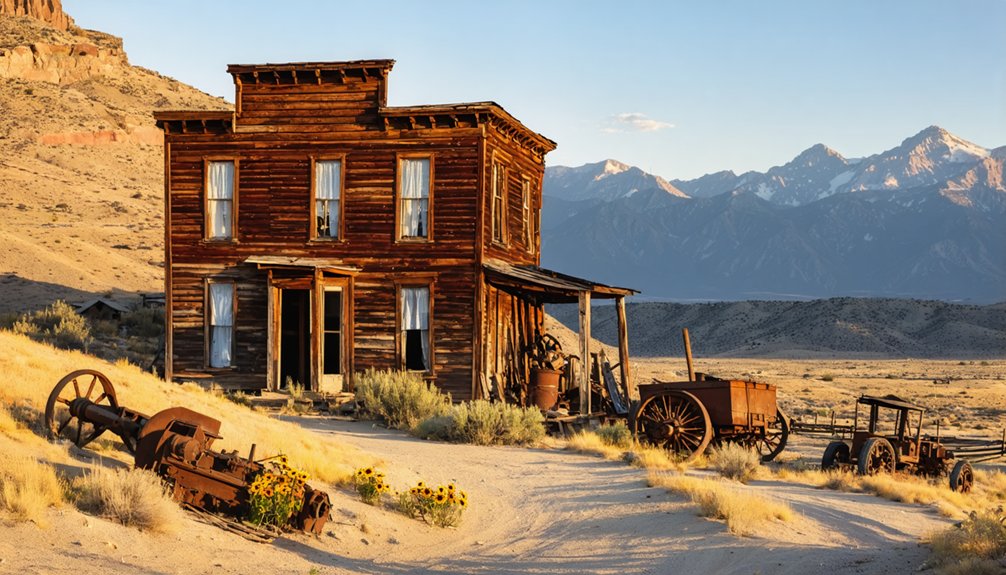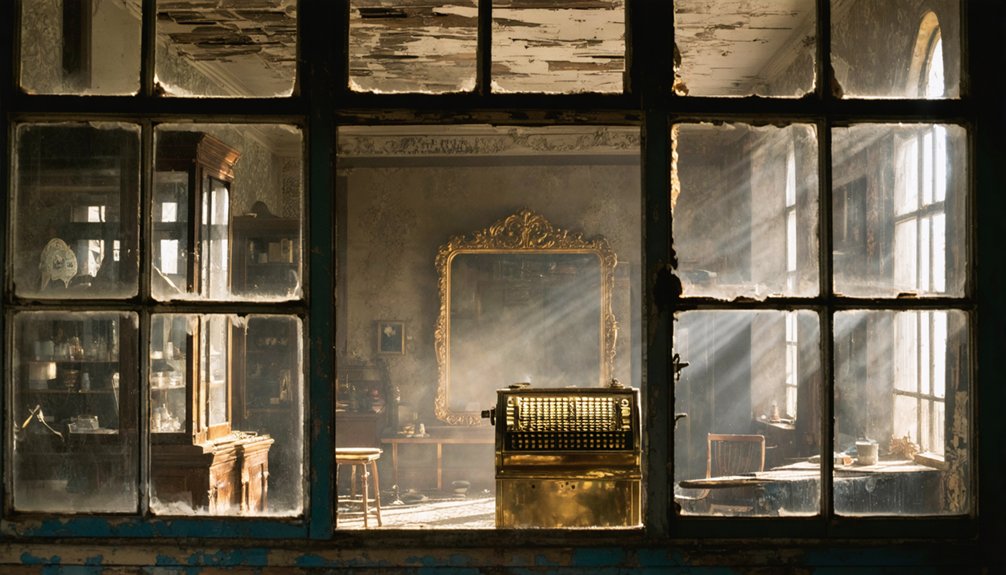California’s abandoned Victorian mining towns offer windows into the dramatic Gold Rush era. You’ll discover sites like Bodie with 110 original structures in “arrested decay” and Calico with its restored 1880s buildings and costumed docents. Each location reveals distinct preservation approaches, from authentic time capsules to commercial attractions. Explore false-front architecture, historic stamp mills, and the remnants of frontier life where boom-and-bust cycles shaped California’s development story.
Key Takeaways
- California’s historic gold rush created Victorian boomtowns that later became ghost towns with preserved architecture and cultural artifacts.
- Bodie State Historic Park maintains 110 original structures in “arrested decay,” offering authentic glimpses of 1880s mining life.
- Calico Ghost Town features restored buildings, costumed docents, and interactive attractions that showcase silver mining heritage.
- Mining towns along Highway 49 preserve false-front commercial buildings, Queen Anne residences, and Greek Revival civic structures.
- Visitors can experience different preservation approaches from Bodie’s untouched authenticity to Calico’s restored commercial development.
The Rise and Fall of California’s Victorian Mining Empires

When the glint of gold first caught James Marshall’s eye at Sutter’s Mill in 1848, few could have predicted the dramatic transformation that would sweep across California. You can trace how this discovery sparked an unprecedented migration of 250,000 prospectors by 1852, each seeking fortune through increasingly sophisticated mining techniques.
The glint of gold at Sutter’s Mill ignited a human tide that forever transformed California’s landscape and legacy.
What began with simple pans and sluices evolved rapidly as immigrant contributions revolutionized extraction methods. Chilean miners introduced the efficient mill and batea, while mercury amalgamation enabled more thorough gold separation. The resulting environmental damage was severe, with water diversion techniques permanently altering California’s landscape and watershed systems.
By the late 1850s, these bustling communities transformed from lawless camps to organized Victorian towns. President James Polk’s official verification of the gold discovery in December 1848 further legitimized the rush and encouraged more settlers to join the migration westward.
Yet freedom was fleeting. As surface deposits depleted, capital-intensive operations replaced individual prospectors. Economic depressions struck, and once-thriving communities emptied, leaving behind ghost towns that silently preserve the legacy of California’s brief but transformative mining empire.
Ghost Towns Frozen in Time: Bodie and Calico
Nestled high in the Sierra Nevada at 8,379 feet, Bodie stands as perhaps America’s most authentically preserved Victorian mining ghost town, capturing a moment when the California Gold Rush’s ambitions collided with harsh reality.
Under a policy of “arrested decay,” its 110 original structures remain largely untouched since their abandonment, complete with dust-covered interiors and personal belongings.
Unlike many historic sites, Bodie faces unique preservation challenges. Staff work year-round to stabilize—but never restore—buildings threatened by harsh mountain weather and time’s relentless march. Daily tours of the Standard Stamp Mill educate visitors on historical gold extraction processes.
The Bodie Foundation battles deterioration while maintaining historical integrity, allowing you to experience the town as it was abandoned.
Ghostly legends persist about this once-lawless settlement where the “Badman from Bodie” reputation was earned through violence and vice during its 10,000-resident peak. For those researching Bodie’s history, it’s important to note that the name refers to multiple places and requires specific disambiguation when searching for information about this particular ghost town.
Daily Life in the Mining Frontier

Despite the romantic visions often portrayed in popular culture, daily life in Victorian mining towns embodied stark hardship and gritty survival.
You’d have found yourself sleeping in crowded shanties on simple bunk beds, gathering around stone fireplaces for warmth and meals of beans and salted meat. Without electricity, miners relied on candles for illumination after sunset, limiting productive hours. Towns like Nevada City became centers of mining activity, surrounded by dense forests in the Sierra Nevada.
Miner’s routines revolved around physically demanding tasks with minimal equipment, while frontier camaraderie developed through shared hardships.
When not working, saloons became the center of social interaction, where dollar bills signed by patrons adorned ceilings as personal markers.
Your daily experience would have included:
- Awakening to bitter cold in poorly insulated quarters
- Laboring for hours with primitive tools and uncertain returns
- Finding moments of relief through community gatherings and storytelling
- Battling isolation and harsh conditions with remarkable resilience
Architectural Remnants of the Silver and Gold Rush
The architectural legacy of Victorian mining towns stands as perhaps the most tangible connection to America’s gold and silver rush era, offering you a three-dimensional historical text written in wood, brick, and stone.
As you walk Main Street in towns like Nevada City or Murphys, you’ll encounter false-front commercial buildings with decorative facades—practical structures designed to project prosperity while utilizing local materials.
Victorian styles dominate these preserved landscapes, from elaborate Queen Anne residences with “gingerbread” trim to utilitarian civic structures built in Greek Revival.
The architectural preservation efforts along Highway 49 have maintained over 90 Victorian buildings in some districts, with original facades and street layouts intact.
These structures—from miners’ frame houses to two-story brick storefronts—reveal the social hierarchy and aspirations of frontier communities.
The Empire Mine Historic State Park in Grass Valley offers visitors a glimpse into one of California’s richest mines, which contributed significantly to the Victorian architectural splendor visible throughout the town.
Early fires and earthquakes destroyed many original structures, prompting merchants to rebuild using more durable materials like brick and stone for longevity.
From Boom to Bust: The Economic Cycle of Mining Settlements

When James Marshall discovered gold flakes in the American River at Coloma in January 1848, he unwittingly triggered one of history’s most dramatic economic transformations.
That glittering discovery in 1848 launched a global economic revolution nobody could have predicted.
You’ll find that these boomtowns followed a predictable cycle—from explosive growth to inevitable decline—revealing stark economic disparities between miners and merchants.
The boom-bust pattern typically included:
- Initial rapid population explosion (Columbia grew from nothing to international boomtown by 1850)
- Brief period of extraordinary wealth generation ($100,000 weekly during peak mining)
- Implementation of discriminatory mining regulations targeting non-white miners
- Economic collapse when accessible gold diminished (Columbia’s property values fell from $1 million to $150,000)
Columbia experienced a particularly sharp decline in the late 1860s as gold became scarce, forcing the remaining 500 residents to find alternative livelihoods in quarries and agriculture.
This economic pattern was also evident in coal mining communities like Clayton, which reached a population of 900 by 1868 during the height of the coal boom.
Exploring These Historic Treasures Today
While mining boomtowns often collapsed under economic pressures, many have found new life as preserved historical sites that offer modern travelers a glimpse into Victorian-era mining culture.
You’ll discover varying degrees of ghost town preservation across California’s historic mining regions. At Calico, explore restored 1880s buildings and underground passages in Maggie’s Mine for just $3.50, while Bodie presents structures in “arrested decay” without commercial amenities.
Visitor experiences range from the fully-developed attractions of Calico—complete with train rides and costumed docents—to the raw authenticity of Forest City, which persists with just four residents committed to historical conservation.
Walter Knott’s restoration work and Glenn Sundstrom’s preservation efforts highlight different approaches to maintaining these treasures.
Whether you prefer Shasta’s dioramas or Ballarat’s weathered adobe ruins, each site offers unique connections to California’s mining heritage.
Frequently Asked Questions
Are There Undiscovered Artifacts Worth Significant Money in These Ghost Towns?
Potentially promising possibilities exist. You’ll find artifact hunting can yield treasure discovery in protected places, though most valuable items were removed long ago. Legal restrictions limit your freedom to collect.
How Dangerous Are Abandoned Mine Shafts to Modern Explorers?
You’re risking your life when exploring abandoned mine shafts. They present severe exploration risks including falls into hidden shafts, toxic gas exposure, drowning, entrapment, and structural collapse without mine shaft safety measures.
Did Any Notable Outlaws or Celebrities Frequent These Mining Towns?
You’ll find outlaw legends like Black Bart and Joaquin Murrieta haunted these towns, while celebrity sightings included Mark Twain, who drew inspiration for his famous works from the colorful mining communities.
Can Visitors Experience Paranormal Activity in California’s Abandoned Mining Towns?
Over 70% of visitors to Bodie report paranormal experiences. You’ll likely encounter ghost sightings at Hotel Leger, where nightly apparitions maintain Moke Hill’s haunted history, especially in preserved structures amid California’s arrested decay.
How Did Victorian-Era Racial Minorities Fare in These Mining Communities?
Racial minorities endured severe discrimination while building remarkable community resilience. You’ll find that African Americans created tight-knit settlements, while Native Americans faced enslavement and Chinese miners experienced violent exclusion amid complex racial dynamics.
References
- https://www.christywanders.com/2024/08/top-ghost-towns-for-history-buffs.html
- https://atomicredhead.com/2025/09/17/boom-to-bust-a-visit-to-the-abandoned-mining-town-of-bodie/
- https://parks.sbcounty.gov/opinion-beyers-byways-a-brief-history-of-calico-ghost-town/
- https://patch.com/california/banning-beaumont/13-ghost-towns-explore-california
- https://www.youtube.com/watch?v=ElbXVNDurPc
- https://edenvaleinn.com/blog/3-gold-rush-towns-near-sacramento/
- https://en.wikipedia.org/wiki/List_of_ghost_towns_in_California
- https://www.loveexploring.com/gallerylist/67994/americas-eeriest-gold-rush-ghost-towns
- https://en.wikipedia.org/wiki/California_gold_rush
- https://www.timetoast.com/timelines/91414



